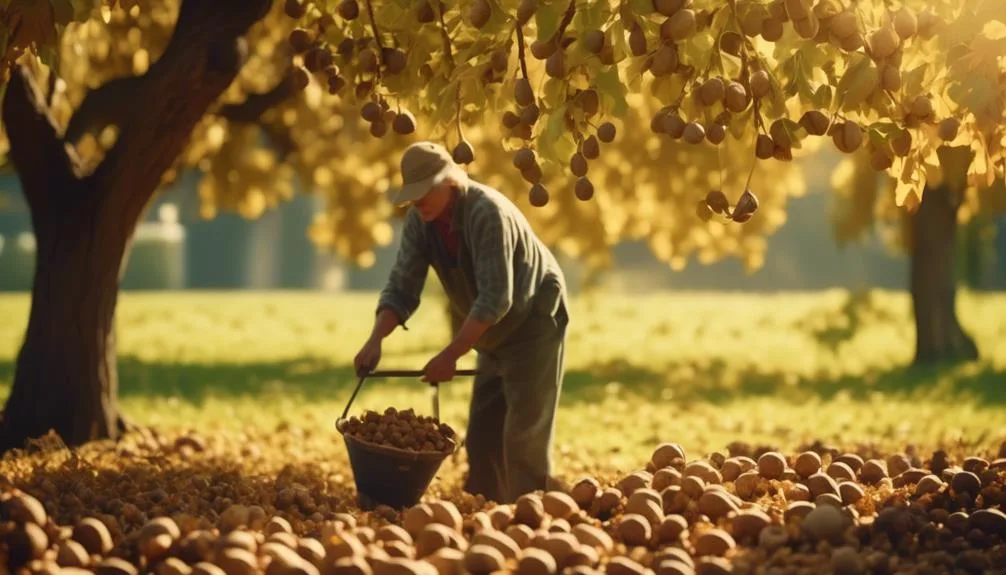Harvesting walnut nuts is like a treasure hunt in your own backyard. It takes patience, attention to detail, and the right techniques for a successful harvest.
From picking the right time to recognizing ripe walnuts, there are important factors to consider. Let's explore the best ways to gather these nutritious and tasty nuts, step by step.
Key Takeaways
- Harvest walnuts when the outer husk begins to split and the inner shell hardens.
- Optimal harvesting conditions for walnuts occur in late summer to early fall.
- Ripe walnuts change color, transitioning from green to yellow or brown.
- Handpick ripe walnuts directly from the tree and crack open the tough outer shell to extract the nutmeat.
Choosing the Right Time for Harvesting
To ensure optimal quality and flavor, it's crucial to harvest walnut nuts at the right time, when the outer husk begins to split and the inner shell hardens. The optimal conditions for walnut harvesting typically occur in the late summer to early fall, depending on the specific variety and environmental factors.
Keep an eye on the trees for signs that the husks are starting to crack open, revealing the walnut inside. This is a clear indicator that the nuts are ripe and ready for harvest. Additionally, pay attention to the color of the hulls and the firmness of the inner shell.
Harvesting season may vary based on your geographical location, so it's important to be aware of the environmental factors that influence the timing for walnut harvesting in your area.
Preparing the Tools and Equipment
Before you begin harvesting walnut nuts, make sure you have the necessary tools and equipment ready for the task. It's essential to select appropriate tools and ensure proper equipment maintenance to make the harvesting process efficient and effective.
Here are the key items you'll need:
- Nut gatherer: A nut gatherer with a long handle will help you collect walnuts from the ground without bending over, saving you time and effort.
- Pruning shears: Sharp pruning shears are crucial for cutting walnut tree branches to reach high-hanging nuts.
- Bucket or basket: A sturdy bucket or basket with a handle will keep your harvested walnuts safe and secure as you move around the orchard.
Identifying Ripe Walnuts for Harvesting
Now that you have the necessary tools and equipment ready, the next step is to identify ripe walnuts for harvesting.
Harvesting season is crucial, and it's important to keep an eye on the color changes of the walnuts. Ripe walnuts typically start to change color, transitioning from green to yellow or brown, depending on the variety.
Look for other identifying signs such as the outer hull cracking open, revealing the shell inside. Additionally, ripe walnuts will often fall to the ground naturally, indicating that they're ready for harvesting.
When you gently shake the branches, ripe walnuts should easily detach and fall.
Harvesting Techniques for Walnut Nuts
Consider using effective Harvesting Techniques to gather ripe walnut nuts.
To ensure a successful harvest, you can employ the following methods:
- Handpicking: Harvest ripe walnuts by handpicking them directly from the tree. Look for nuts with a firm outer hull and use gloves to avoid staining your hands.
- Nut cracking: After harvesting, use a nutcracker to crack open the tough outer shell of the walnut. Extract the edible nutmeat from the shell, taking care to preserve the intact halves.
- Walnut shelling: Utilize a walnut sheller to efficiently remove the nutmeat from the shell in large quantities. This method is ideal for larger walnut harvests and can save time and effort during the shelling process.
Post-Harvest Processing and Storage
After handpicking and cracking the ripe walnuts, it is essential to proceed with the post-harvest processing and storage to maintain the quality and flavor of the nutmeat. The nut drying process is crucial to reduce moisture content and prevent mold growth. One effective method is to air-dry the nuts in a single layer in a well-ventilated area for two to three weeks. Alternatively, you can use a food dehydrator set at a low temperature. When it comes to nut cracking methods, using a nutcracker or a hammer is the most common approach. However, for larger quantities, a mechanical nutcracker can save time and effort. Properly dried and cracked walnuts should be stored in a cool, dry place in airtight containers to maintain their freshness and flavor.
| Nut Processing and Storage | Description | Benefits |
|---|---|---|
| Nut Drying Process | Air-drying or dehydrating | Preserves flavor and prevents mold growth |
| Nut Cracking Methods | Manual or mechanical | Efficient and effective for maintaining quality |
Conclusion
Get ready to savor the rewards of your hard work as you harvest walnut nuts using the best techniques. By timing your harvest right, using the proper tools, and identifying ripe walnuts, you can enjoy the delicious and nutritious nuts year-round.
With careful post-harvest processing and storage, you can ensure a steady supply of walnuts for your enjoyment.
Happy harvesting!

